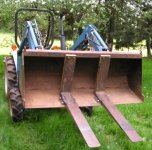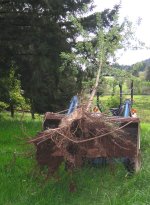CliffordK
Veteran Member
- Joined
- Mar 8, 2013
- Messages
- 2,383
- Location
- Eugene, Oregon
- Tractor
- Toro D200, Ford 1715, International 884,
I've seen several posts about adding little teeth to one's bucket...
I thought tusks would be better.


I only had two. I set them a little narrow to suit my needs at this time. I'm not carrying around pallets at the moment, but could redrill my holes if I need to set them wider.
If I was doing it again, rather than welding on ears, I might consider drilling and tapping the forks. But this seemed to work for what I needed.
I did loose a little more dirt than I had hoped, but I certainly couldn't hold the root ball together with the stock bucket.
I thought tusks would be better.


I only had two. I set them a little narrow to suit my needs at this time. I'm not carrying around pallets at the moment, but could redrill my holes if I need to set them wider.
If I was doing it again, rather than welding on ears, I might consider drilling and tapping the forks. But this seemed to work for what I needed.
I did loose a little more dirt than I had hoped, but I certainly couldn't hold the root ball together with the stock bucket.
